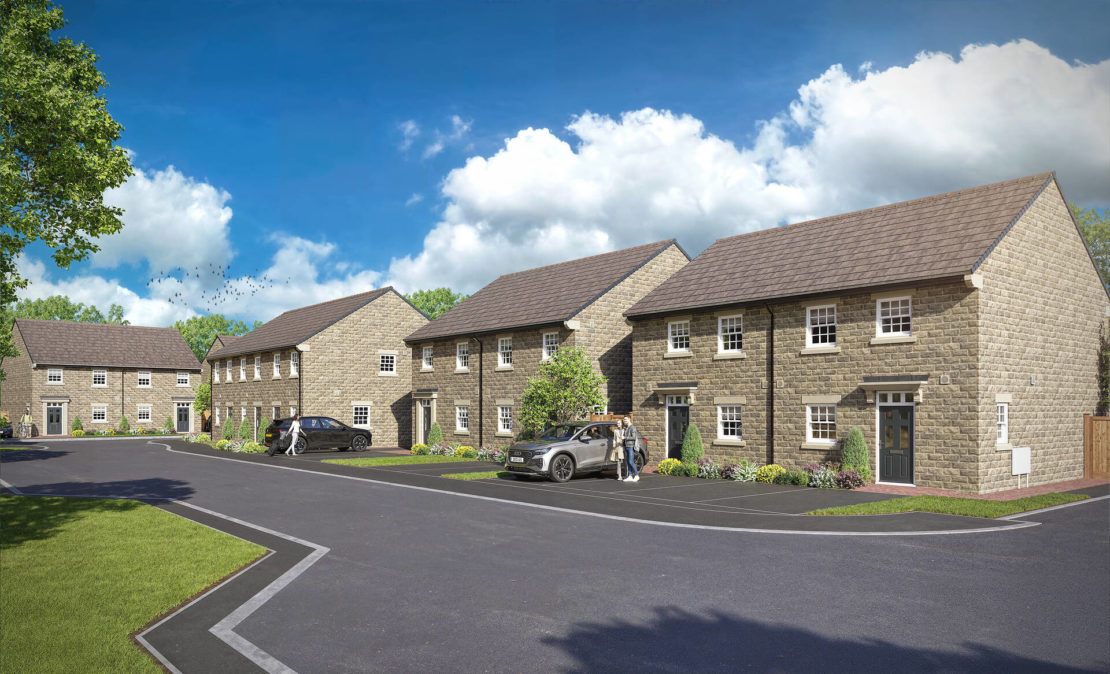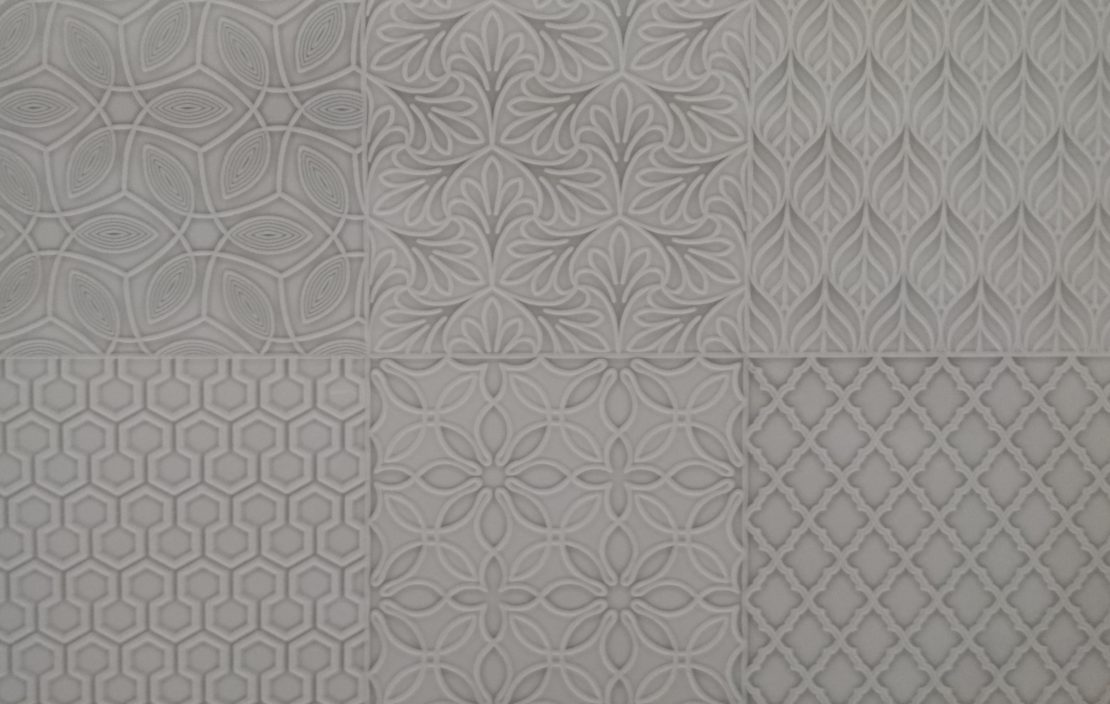
Tiling is one of those areas of interior design that you want to get right first time. If you grow bored of a colour on a bedroom wall, you can easily paint over it. If your lounge wallpaper is no longer to your taste, you can strip it away within a few hours. Tiling is a different matter – the hassle and expense involved in changing it means that, once you’ve made your decision, it’s likely to be in place for many years to come.
With that in mind, our customers often ask for advice on the subject. Over the years we’ve discussed the ins and outs of tiling design with countless homebuyers, so we thought we’d offer a few key pointers on how to approach your choice…
Consider the room’s size and natural light
As a starting point, it’s worth taking the room’s dimensions into account. Large-format tiles (below left) are more suitable for larger bathrooms. Mosaic tiles could be a wiser choice for smaller spaces like cloakrooms. Lighter colours can make compact spaces feel larger, but you could still make subtle use of dark tiling for a splashback (below right) to inject a contrasting tone.
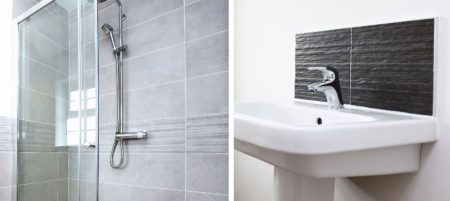
Darker colours can provide a dramatic, moody feel punctuated by colourful furniture, but brighter hues might be a better option if the room has a lack of natural light. A lighter grey (below) is every bit as chic and combines well with almost every other colour in the spectrum.

Mix things up with an accent feature
One of the key decisions to make is whether to select plain wall tiling, textured/patterned wall tiling or a mixture of both. Many people opt for one without the other, but plain tiles and textured/patterned tiles are not mutually exclusive and often work well together. The below example shows a plain marble finish alternated with vertical strips of wave patterned tiling which creates an accent feature to one wall. A similar effect could be achieved with the use of herringbone tiles, currently a very popular bathroom trend. Plain and mosaic is also a classic combination.
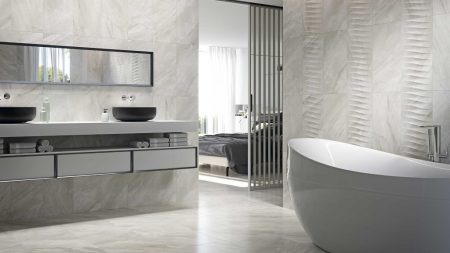
A subtle variation also works with textured tiles forming a horizontal band (see below) between a painted wall and plain tiles.
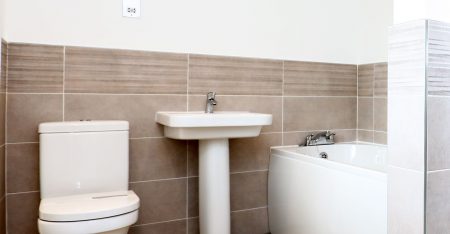
Similarly, there are no hard and fast rules for your choice of floor tiling to accompany the wall tiles. Most tiling ranges offer matching variations for floors – in other words, the same style/pattern as the wall, but in a slightly different shade, or the same colour applied to a contrasting style/pattern. Manufacturers use experienced designers to develop these complementary looks, so it’s an easy and stress-free choice to go with one of their standard pairings. If you choose floor tiling that’s identical to the wall tiling, it’s worth incorporating a dash of accent tiling to prevent the scheme from looking too monotonous and featureless. Alternatively, you could follow your own instincts and mix and match between different ranges to create a sharper contrast between wall and floor – it’s a bold approach which could be rewarded with a striking statement, but make sure you’re 100% sure before you take the plunge!
Take some natural inspiration for the spa feel
Creating a spa-like aesthetic in the bathroom can heighten your sense of relaxation and rejuvenation. The best way to achieve this is tile design which takes its inspiration from nature: stone, slate, pebble and the perennially popular style of marble. You could opt for the real thing, but many stone-effect and marble-effect tiles can look every bit as authentic whilst being far less expensive.
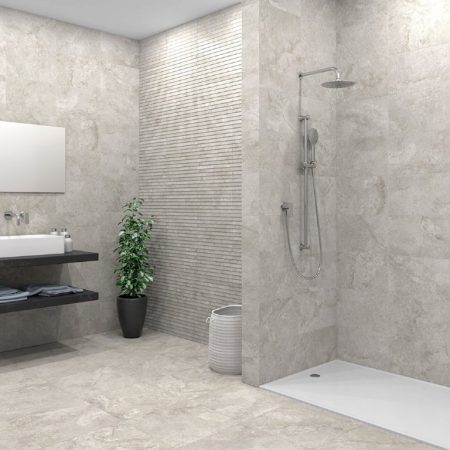
You can enhance the natural feel with textured surfaces on wall tiles (below left) or floor tiling which provides a detailed replication of wood grain (below right) without the maintenance issues that can occur with real wood on splash-prone bathroom surfaces.
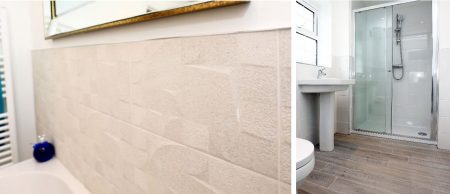
Multi-patterned features can be easier than they look
Multi-patterned tiling – bringing together a medley of designs in a ‘patchwork’ feature – is an increasingly popular option, but it can be difficult to pull off the look unless you have an eye for combinations that complement each other. Fortunately, you can take a short-cut to achieve this aesthetic – most manufacturers supply visually compatible assortments in standard sets and some manufacturers supply large-format tiles that appear to be a collection of medium-sized tiles pieced together. The below example is a single large-format tile manufactured to give the appearance of six different tiles – a ready-made harmony of styles that’s faster to fit!
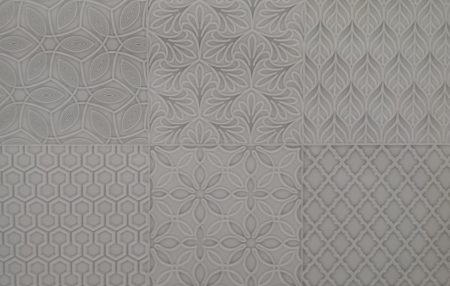
Whilst some tiles contain multiple patterns, others are supplied in sets that combine as one pattern. The below example is a set of four symmetrical large-format tiles forming a period-style Victorian Moroccan design which looks fantastic on a bathroom floor or a hallway. A similar combination could be utilised for medium-sized tiles to create a feature wall in a bathroom or between kitchen worktops and cupboards.
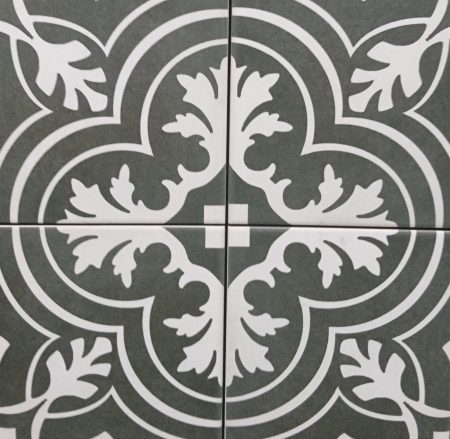
Consider the practicalities
Whilst tiling design is open to all sorts of aesthetic possibilities, you may want to ponder the everyday practicalities too. Some tiles require more regular cleaning than most in order to maintain an immaculate appearance – water (and resulting residue) tends to settle more on natural tiles and surfaces with textures, contours or indentations. Pebble tiles offer a distinctive style, but they can be high-maintenance. If you want to minimise the amount of time you devote to household chores, smooth tiles require the least upkeep. It’s also worth noting that glossy black floor tiles often show up dirt more than lighter coloured versions.
Seek out advice and opinions!
A short time spent on Google will reveal a multitude of styles, materials and finishes to offer some inspiration. If you see something you like, save it and keep looking until you’re satisfied with your homework. When you’ve narrowed down a shortlist of favourites, share it with friends or family to get a second opinion – they might be able to offer some insight that you haven’t considered.
Orion Homes offer a comprehensive range of high-quality tiling options for our bathrooms, kitchens and utility rooms – our Sales Advisors are very experienced in providing guidance on styles, combinations and design nuances that serve our customers’ tastes and needs. With our help, you can make a choice that will stand the test of time!

